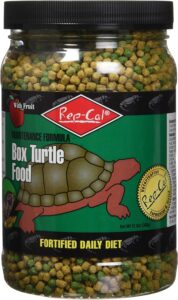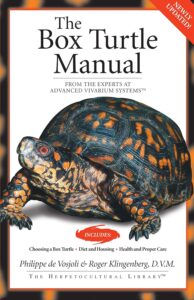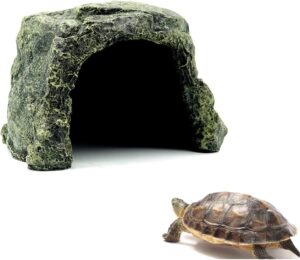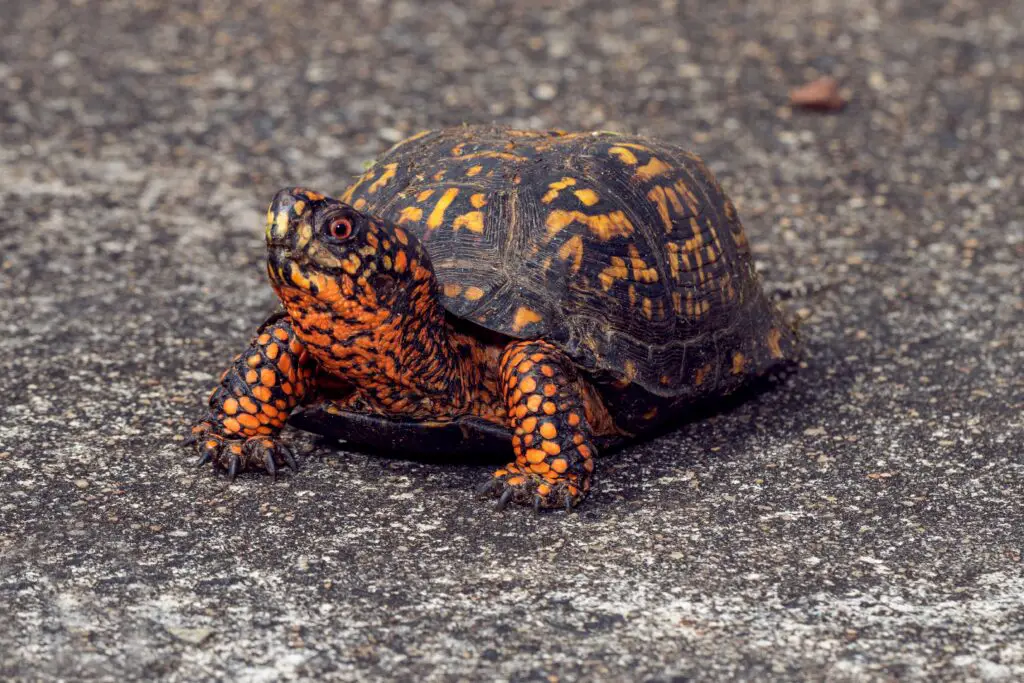How big can a box turtle get
How big can a box turtle get: A box turtle is a fascinating creature that belongs to the genus Terrapene, which comprises several species native to North America. These small to medium-sized land turtles are known for their domed carapace (top shell) and hinged plastron (bottom shell), which allows them to completely enclose themselves within their shells as a defense mechanism. Box turtles are highly adaptable and can be found in various habitats, including woodlands, grasslands, and wetlands.
Definition of a box turtle
 The term “box turtle” is commonly used to refer to any turtle belonging to the Terrapene genus. However, it’s important to note that there are four recognized species of box turtles: Eastern box turtle (Terrapene carolina), Western box turtle (Terrapene ornata), Gulf Coast box turtle (Terrapene carolina major), and Three-toed box turtle (Terrapene carolina triunguis). These species exhibit slight variations in physical characteristics, habitat preferences, and geographic distribution.
The term “box turtle” is commonly used to refer to any turtle belonging to the Terrapene genus. However, it’s important to note that there are four recognized species of box turtles: Eastern box turtle (Terrapene carolina), Western box turtle (Terrapene ornata), Gulf Coast box turtle (Terrapene carolina major), and Three-toed box turtle (Terrapene carolina triunguis). These species exhibit slight variations in physical characteristics, habitat preferences, and geographic distribution.
Box turtles are characterized by their distinctive appearance. Their carapaces range from shades of brown to black, often adorned with intricate patterns or markings unique to each individual.
The plastron tends to be hinged at the bottom allowing the shell halves to close tightly together when threatened. Their heads feature a hooked upper jaw and bright eyes positioned on either side, granting them an excellent field of vision.
Fascination with the size of box turtles
The size of box turtles has captivated the interest of researchers, enthusiasts, and nature lovers alike for several reasons. Firstly, understanding how big a box turtle can get provides valuable insights into their growth patterns and life history traits. It helps us comprehend factors such as sexual dimorphism—the differences in size between males and females—and the impact of environmental variables on their growth rates.
Additionally, the size of box turtles has practical implications. It enables us to differentiate between hatchlings, juveniles, subadults, and adults, facilitating their classification when studying populations in the wild or managing them in captivity.
By examining variations in size across different subspecies and geographic locations, we can gain a better understanding of their evolutionary adaptations and genetic diversity. The sheer charm and curiosity surrounding box turtles make their size an intriguing aspect to explore.
Observing these charming creatures up close and marveling at the intricate details of their shells can evoke a sense of wonder and appreciation for nature’s beauty. Whether it’s admiring a tiny hatchling or encountering a fully grown adult in its natural habitat, appreciating the diverse sizes that box turtles can reach adds to our fascination with these remarkable reptiles.
General Overview of Box Turtle Size
Box turtles, scientifically known as <i>Terrapene carolina</i>, are captivating creatures that have captivated the curiosity of many reptile enthusiasts. Understanding the typical size range for adult box turtles is fundamental to appreciating these remarkable reptiles.
Adult box turtle size can be assessed based on their length and weight. While individual turtles may vary slightly, there is a general average range that can provide valuable insights.
Average size range for adult box turtles
When it comes to the length of adult box turtles, measurements typically fall within the range of 4 to 8 inches (10 to 20 cm). This measurement is considered standard across various subspecies and geographical regions.
However, it is worth noting that there may be some variations depending on environmental factors such as diet and habitat conditions. In terms of weight, adult box turtles usually weigh between 0.5 to 1 pound (0.2 to 0.5 kg).
Like their length, weight can also fluctuate slightly among individuals depending on various factors such as age, sex, and overall health. The size range mentioned provides a general guideline for understanding the average weight category for adult box turtles.
Sexual dimorphism in box turtles
 Sexual dimorphism refers to the physical differences between males and females within a species. In the case of box turtles, this dimorphism manifests itself through variations in size between males and females.
Sexual dimorphism refers to the physical differences between males and females within a species. In the case of box turtles, this dimorphism manifests itself through variations in size between males and females.
Males tend to be slightly larger than females in most cases; however, this difference becomes more noticeable with age. As hatchlings and juveniles, male and female box turtles are relatively similar in size; it is when they reach adulthood that these distinctions become more pronounced.
This sexual dimorphism in size is believed to be associated with reproductive strategies and behaviors. Larger males may have an advantage in competitive mating situations, and thus, natural selection has favored slightly larger size in males over time.
Factors Influencing Box Turtle Size
Geographic Location and Subspecies Variation
When examining the size of box turtles, it is crucial to consider their geographic location and subspecies variation. Different subspecies of box turtles exhibit varying sizes and growth rates, clearly highlighting the influence of their environment on their development. For instance, the Eastern box turtle (Terrapene carolina carolina) tends to be larger than its western counterparts such as the Western box turtle (Terrapene ornata).
The subtle differences in size between these subspecies can be attributed to a combination of genetic factors and adaptation to specific habitats. The Eastern box turtle, which inhabits regions extending from eastern Canada down to Florida, possesses a more robust frame compared to its western relatives.
This could be due to the fact that Eastern box turtles inhabit diverse ecosystems ranging from forests and grasslands to wetlands. These varied environments provide abundant resources for growth and contribute to their generally larger size.
On the other hand, Western box turtles are found predominantly in arid regions with less plentiful food sources. Consequently, they tend to have smaller body sizes as an adaptation for conserving energy in their challenging habitat.

Diet and Nutrition Impact on Growth Rate and Size Potential
The diet and nutrition of a box turtle play a significant role in determining its growth rate and eventual size potential. A balanced diet rich in protein, calcium, vitamins, minerals, and essential nutrients is vital for promoting healthy growth throughout all developmental stages.
Protein is especially crucial during periods of rapid growth observed in juveniles. A key factor contributing to healthy shell development is an adequate intake of calcium combined with proper exposure to ultraviolet (UV) light for vitamin D synthesis.
Calcium ensures strong bone structure while UV light aids in calcium absorption by stimulating metabolic processes within the turtle’s body. Insufficient calcium in the diet or lack of access to UV light can lead to stunted growth, weakened shells, and various health issues.
Availability of Food Sources Affects Overall Size Potential
The availability of food sources directly impacts the overall size potential of box turtles. In their natural habitats, box turtles have a diverse omnivorous diet that includes insects, earthworms, snails, berries, fruits, and vegetation.
The abundance and variety of these food sources greatly influence an individual turtle’s growth trajectory. In areas where resources are scarce or restricted due to environmental factors such as drought or habitat destruction, box turtles may experience limited access to quality food.
This can result in reduced growth rates and smaller adult sizes. Conversely, in regions with ample food availability and favorable conditions for foraging throughout the year, box turtles have the opportunity to reach their maximum size potential.
Growth Stages of a Box Turtle
Hatchlings
 Hatchlings are the epitome of delicate beauty, measuring a mere inch in length and weighing only a few grams at birth. Their small size is truly awe-inspiring as they emerge from their eggs, exhibiting the intricate patterns and colors that adorn their shells.
Hatchlings are the epitome of delicate beauty, measuring a mere inch in length and weighing only a few grams at birth. Their small size is truly awe-inspiring as they emerge from their eggs, exhibiting the intricate patterns and colors that adorn their shells.
However, despite their adorable appearance, hatchlings undergo a slow growth rate during the first few years of their lives. This gradual development allows them to acclimate to their environment while building strength and resilience for the journey ahead.
Juveniles
As hatchlings transition into juveniles, they experience an exhilarating growth spurt that propels them towards adulthood. During this stage, these young box turtles can achieve an impressive increase in length of approximately an inch per year.
The sheer speed at which they grow is remarkable and showcases nature’s incredible ability to facilitate rapid development. Additionally, weight gain becomes significant during this phase but may vary depending on factors such as diet quality and availability of food sources.
Subadults
Approaching adult size yet still in the process of growth, subadult box turtles exude a captivating blend of elegance and potential. During this stage, their growth rate gradually slows down compared to the rapid pace observed during their juvenile years.
As these turtles continue to mature physically and mentally, they enter a transformative period where both their shell hardens and distinct patterns begin to manifest. This unique transformation solidifies their identity as truly magnificent creatures within the reptilian realm.
To sum up How big can a box turtle get
The journey from hatchling to subadult for a box turtle is nothing short of extraordinary. These resilient creatures undergo remarkable transformations through each growth stage; from tiny hatchlings venturing into the world with tender curiosity, through juveniles experiencing exciting periods of accelerated growth, all the way to subadults on the cusp of adulthood.
The slow and steady pace with which box turtles grow allows them to adapt, develop strength, and ultimately thrive in their environment. Witnessing their growth serves as a reminder of the beauty and resilience of nature itself, leaving us with a profound appreciation for these captivating reptiles.
Further Reading
How To Keep My Turtle Tank From Smelling
How To Decorate a Turtle Tank: DIY Guide


